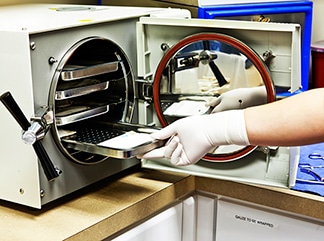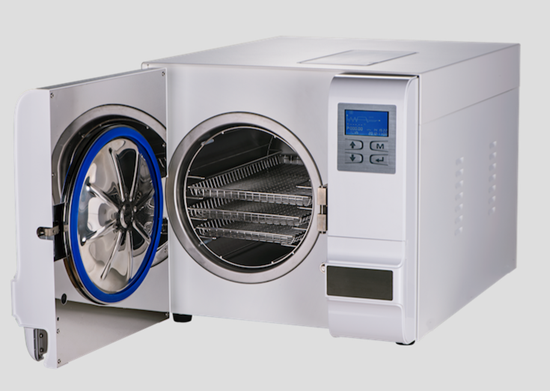Sterilization is a process of destruction of all forms of living microorganisms from a substance.
Articles having direct application on humans and animals are subjected to sterilization.
These materials include drugs, nutraceuticals, surgical equipment, food, etc.
Sterilization is done to preserve the substance for a long time without decay.
Secondly, a substance that is not sterile may contain microbes which may cause infections when consumed or administered.
So sterilization is essential. The microbes are invisible to naked eye, and even those like bacteria have a protective sheath on their surface making them resistant to sterilization.
For this effective sterilization techniques are designed and studied in microbiology.
The Methods of Sterilization include
- 1. Heat methods.
- 2. Chemical sterilization.
- 3. Filtration method
Heat method of sterilization: This is the most common method of sterilization. The heat used kills the microbes in the substance. The temperature of the heat and duration of heating are the factors that affect the extent of sterilization.
In heat sterilization process, the longer the exposure to heat the better is the sterilization at a given temperature. As the temperature of heat raises the timespan required for sterilization decreases.
Further, the sterilization time increases with a decrease in temperature and vice-versa. But one needs to maintain minimum sterilization time or minimum contact time for the heat to be in touch with microbes or bacteria and thereby kill them.
The heat method of sterilization is again of two types based on the type of heat used.
- A) Moist heat methods.
- B) Dry heat methods.
Moist heat method of sterilization: Here heat is applied in the form of steam or just boiling. This method includes techniques like
- Boiling
- Pasteurization
- By use of steam (Autoclave).
Boiling is preferred for metallic devices like surgical scissors, scalpels, needles, etc. Here substances are boiled to sterilize them.
Pasteurization is the process of heating the milk at a temperature of 6o degrees or 72 degrees 3 to four times. Here alternative heating and cooling kill all the microbes and molds without boiling the milk.
Using Steam (autoclaving): Here the substances are subjected to sterilization in an autoclave a steam sterilization equipment. The process is carried out at a temperature of 115 degrees for 60 min or 121 degrees for 20 min at 15psi pressure.
The saturated steam is formed at boiling temperature of water, i.e.,100 degrees.
This steam condenses on the material and relieves the latent heat repeatedly to convert back into the water.
Further, the saturated steam under pressure penetrates all the narrow spaces leaving no microbes alive thereby making the sterilization very efficient.
It is the most common method used for drugs as it is powerful enough even to kill bacterial spores.
Bacterial spores are the forms of bacteria which are inert. They form a rigid cover over the cell wall during harsh climate. This cover prevents any damage to cell and drying of the cell. By steam sterilization, these forms of bacteria are also killed as steam destroys the cell wall.
Dry heat methods: Here the substances are subjected to dry heat like
- Flaming
- Incineration
- Hot air oven
- Radiation
- sterilization
Flaming is the process of exposing metallic device like the needle, scalpels, scissors to flame for few minutes. The fire burns the microbes and other dust on the instrument directly.
Incineration is done especially for inoculating loops used in microbe cultures. The metallic end of the loop is heated to red hot on the flame. This exposure kills all the germs.

Hot air oven is suitable for dry material like powders, metal devices, glassware, etc.
Here thermostable materials on the racks inside the hot air oven.
Then in the closed oven, hot air is circulated at particular temperature and time.
Radiation method involves exposing the packed materials to radiation for sterilization. There are two types of radiations available for sterilization, i.e., non-ionic and ionic radiation.
Non-ionic radiations are safe to the operator of sterilization, and they are like Ultra Violet radiations, they can be used even at the door entrances to prevent entry of live microbes through the air.Ionizing radiation sterilization. They are powerful radiation and very useful for sterilization. The operator needs to protect himself from exposure from these radiations by use of unique clothing. Ex: X-rays, γ-rays, etc.
Chemical method of sterilization: Here the articles are subjected to sterilization by using toxic gasses. The gas penetrates quickly into the material like steam so, the sterilization is effective. But the chances of explosion and cost factors are to be considered.
The gasses used for sterilization are very poisonous. The commonly used gas is ethylene oxide with a combination of carbon-dioxide. Carbon dioxide is added to minimize the chances of an explosion.
Filtration: Here the liquids are filtered through bacterial filters to remove any microbes present. This method is very useful for sterilization of heat sensitive liquids. The chances of clogging and long time duration for the process to happen are drawbacks.
For sterilization three types of filters are used viz.
A) Membrane filters: These are thin filters which are made of cellulose. They can be employed for online sterilization during injection by placing the membrane between the syringe and needle. They are highly efficient to sterilize liquid, solvents, gasses.
The disadvantage is there are chances of rupture of membrane leading to improper sterilization.
B) Seitz filters: These are made of asbestos or other material. They are pad like and thicker than membrane filters. They do not rupture during filtration. But the solution might get absorbed by the filter pad itself.
An alternative type of filter is sintered glassfilters. These are made of glass and hence do not absorb liquids during filtration. The disadvantage is that they are very brittle and break easily.
c) Candle filters: These are made of clay like diatomous mud. This special mud has minute pores made of algae. The filters have many tiny lengthy pores. The microbes get stuck during their travel through the pore in the candle.
So of the available methods,
- Methods of sterilization of surgical instruments are Boiling, Incineration, Autoclave.
- Methods of sterilization of glassware are autoclave, boiling and also the hot-air oven.
3. Methods of sterilization of water we use filtration and for other moist liquid material autoclave.
4. For powders and other dry forms, it is hot air oven if thermostable or gaseous methods and radiation.
5. Methods of Sterilization in hospitals are for metallic surgical instruments boiling, autoclave, incineration can be done. To prevent microbial contamination due to air. UV radiation lamps for sterilization can be arranged at the doors.
Also, ultrasound waves are being tested for sterilization. Though it is not as effective as other methods, it was found to be useful in tissue cultures. Here the aim is to sterilize or even prevent the growth of bacteria during culturing of tissue.
Written By Ranga.nr

